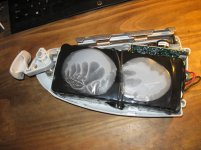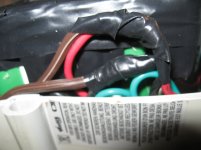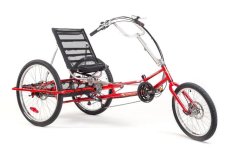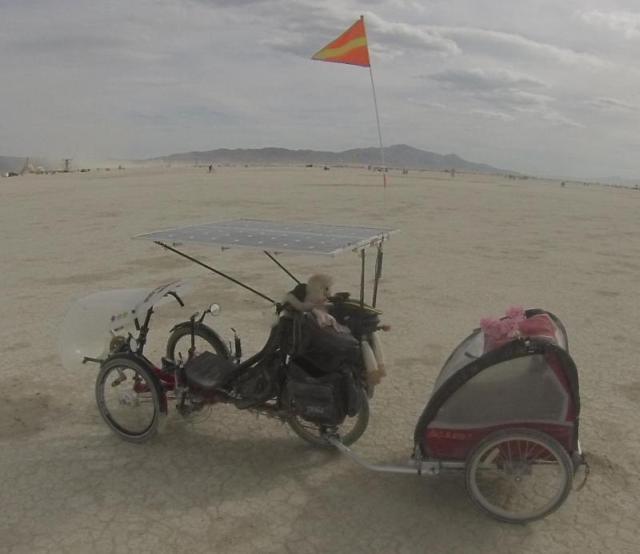While reading the below (and my previous stuff) keep in mind all of my lighting opinions ar ejust that: opinions, not scientifically-tested fact. It's based on my years of riding around observing and some basic experimentation, but not an actual study with any control factors. So my conclusions could be completely wrong, even though they seem to serve me well enough so far. Just because they are logical doesn't mean they're right.

icerider said:
I don't know what the effect of the flashing lights is on people. They are painfully bright and impossible not to see in my rural setting, but as you point out, don't give much sense of size.
Well, the thing about point source lights is that you can't really tell how far away it is, can't easily and instantly judge how fast it's moving relative to you, etc. The larger the surface area of the light is, the closer it appears and the easier it seems to be to judge it's speed...BUT: In general, most car headlights are about the size of your open hand, with fingers not spread out. So if you use lights that have a lit surface area of that size, drivers' brains are already programmed (usually) to judge speed/distance. If you can put a pair of them on there, one over each front wheel of the trike, it'd be even better cuz then they can use the changing distance between them to judge approach angle and distnace and speed.
But in your case, most of the problems aren't with headlights, it's with taillights, because in your situation it's a lot less likely to have a head-on collision wiht a car than to have one run you over from behind.

(in city traffic it makes a whole lot more difference for the headlight thing, becuase of all thos people pulling out of side streets, driveways, etc., and those in oncoming lanes about ot cross your path without signalling to get into one of those side streets, driveways, etc). In your case, the most important thing about hte headlight is YOU being able to see where you're going in time to react to anything you see in your path. Personally, I think a steady headlight instead of flashing would suit you better for that, but you'd have to experiment and see for yourself, if you haven't already.
For taillights, AFAICT, just having more of the back of the vehicle lit up with lights bright enough to be seen from a goodly distance, and/or lots of reflective surface area (like that red/white tape I have on mine, and/or regular bike/car/MC reflectors, etc) will help, even if it is all just steady lighting. Having it all wired up so that it brightens dramatically when you are braking helps, too, especially if you see someone approaching you way too fast you can tap your brakes to blink the lights and they almost certainly *will* see you and either slow down or at least change lanes and not run you over as they speed thru the area at two or three times the posted limit. :/
It also helps with the downlighting, lighting up the surface of the road itself. It makes you look bigger, and easier to see from a distance. Ever see a motorcycle or scooter with the old licenseplate light that lit up the road all around hte back end of the bike for several feet? Vs many of hte new ones that use just a little bitty LED that only lights up the actual plate? The new ones look a lot smaller on the road than the old ones did. Their actual taillights are often many times brighter than the old incandescent types, but they still look smaller, and thus farther away, and it appears as if one has more time to react to them than one actually does. :/
I can tell you that deer are absolutely TRANSFIXED by the flashing headlight. They stand there with their mouths open and simply EXPLODE when I get close enough for them to see how big I am and how fast I am going. Even the deer that know me keep their distance when the lights are on. Normally I can ride past them with no more than a few feet of separation but with the lights on they give me a wide berth.
Well, the expression "deer in headlights" for someone jsut standing htere in surprise did come from somewhere, you know.

They (and some other animals) simply get surprised by things like that, and don't know what to do. It isn't in their programmed responses, and they don't always "learn" new ones very well, it seems. Cows and goats are like that, too, in my farm-country experience. :lol:
I like the idea of extended light sources, especially the one about mimicking the lane change sign. I thought about getting a string of LEDs and just sort of outlining the bike -- at least the back end. I would like to keep at least a little of my night vision. The LED strings do not draw a lot of power and of course, the power they draw depends on how long the string is. 18ft of waterproof LED string is ~$10 and wants 3A @ 12V.
Yep. Generally, as long as it's "legal" colors for the direction its facing, more lighted area can't hurt.

The only worry is if someone tries to apply some of the restrictions on number and types of lights for *motor vehicles* to you, when you are not a motor vehicle, and only have to obey the bicycle lighting laws (which in AZ I do not think restrict the number of lights you can have, only mandate that you have a headlight and tailight visible from such and such a distance, and certain reflectors). Certainly I've never had anyone complain about my lighting, and indeed been thanked by police for having it, more than once. :lol: I just make sure that any light sources actually visible from the rear are only red or amber, and anything that is red is not visible from the front, and I don't use anything other than red, amber, or white lights.
I also don't use flashing lights except for turn signals, because I find that drivers see a flashing light (especially a small point source, regardless of brightness, red, or white) as a very slow bicycle and completley misjudge how fast I am going (usually 18-20MPH, sometimes less), which results in me having to dodge them or them having to brake very suddenly when they finally realize I'm not toodling along at 5-8MPH.

They do *see* me, they just don't seem able to properly judge speed or position from it. I've considered testing flashing lights *plus* my regular lighting, but since it's not generally on other road vehicles *except* bicycles, I have a feeling it isn't going to change anything, plus I *know* they can see me already as it is. :lol:
I forget what my downlighting LED strips take for power, but it generally doesn't detract from my vision because almost all of the light from it is below and behind me.
There's MUCH more overspill in front from my car headlight, but even that isn't a problem, because most of my problems come from headlights from oncoming cars, and from advertising signage and spotlights lighting up the sides of buildings and other signage, with too much overspill shining into roadways and such (and they are very bright near-point-sources, often enough). It's like a headlight-cold-war, too, since as some people get brighter lights in their cars, others have to have brighter lights to be able to see the road now because of the blinding lights from the other cars, and then other cars have to get even brighter ones themselves, and so on, until nowadays I can't see the road at all with oncoming traffic unless I also have lights as bright as theirs. (presently it is an old Sylvania halogen from an '85 Ford LTD, using both low and highbeam filaments at the same time, whenever there is oncoming traffic, otherwise just lowbeam).
Use only 6ft and that is a manageable 12W @ 12V -- a tiny DC-DC board can make that from bike voltage with no trouble and very little heat output.
You can also often use old wallwarts from other things, easily found at Goodwill and other thrift stores (if you have such things up there), as DC-DC converters. As long as they are not heavy transformer types, many of them will run on DC input as well as AC, and at sometimes less than half of their rated minimum input voltage. There's bajillions of ~12V adapters out there for LCD monitors and such, and lots of them will work on 50-60VDC for starting up.
I am presently using a Rayovac 14.4VDC output charger wallwart as my "12V" lighting power converter, running off my traction pack. I am now using 14.4V because it's closest to automotive voltages, adn that's the lighting types I prefer to use, so they work best at that voltage, and are often much dimmer at only 12V.
I've used several different kinds with varied levels of success, including actual DC-DC converters, but the wallwarts are cheaper and often nice sealed-up units (not fully waterproof but hardly ever need that here, and would be easy enough to fix that). (I also use a 4s 16V pack to run my car headlight, cuz it's just too power-hungry to run at it's full brightness off any of the DC-DC's or wallwarts I've got that will still run off my traction pack. Eventually I will get around to replacing it's halogen bulb with LEDs or something).






